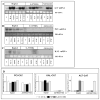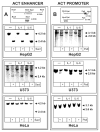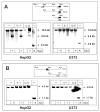Astrocyte- and hepatocyte-specific expression of genes from the distal serpin subcluster at 14q32.1 associates with tissue-specific chromatin structures
- PMID: 15969742
- PMCID: PMC4557805
- DOI: 10.1111/j.1471-4159.2005.03204.x
Astrocyte- and hepatocyte-specific expression of genes from the distal serpin subcluster at 14q32.1 associates with tissue-specific chromatin structures
Abstract
The distal serpin subcluster contains genes encoding alpha1-antichymotrypsin (ACT), protein C inhibitor (PCI), kallistatin (KAL) and the KAL-like protein, which are expressed in hepatocytes, but only the act gene is expressed in astrocytes. We show here that the tissue-specific expression of these genes associates with astrocyte- and hepatocyte-specific chromatin structures. In hepatocytes, we identified 12 Dnase I-hypersensitive sites (DHSs) that were distributed throughout the entire subcluster, with the promoters of expressed genes accessible to restriction enzyme digestion. In astrocytes, only six DHSs were located exclusively in the 5' flanking region of the act gene, with its promoter also accessible to restriction enzyme digestion. The acetylation of histone H3 and H4 was found throughout the subcluster in both cell types but this acetylation did not correlate with the expression pattern of these serpin genes. Analysis of histone modifications at the promoters of the act and pci genes revealed that methylation of histone H3 on lysine 4 correlated with their expression pattern in both cell types. In addition, inhibition of methyltransferase activity resulted in suppression of ACT and PCI mRNA expression. We propose that lysine 4 methylation of histone H3 correlates with the tissue-specific expression pattern of these serpin genes.
Figures







Similar articles
-
Astrocyte-specific expression of the alpha1-antichymotrypsin and glial fibrillary acidic protein genes requires activator protein-1.J Biol Chem. 2006 Jan 27;281(4):1956-63. doi: 10.1074/jbc.M510935200. Epub 2005 Nov 22. J Biol Chem. 2006. PMID: 16303762
-
Formation of a large, complex domain of histone hyperacetylation at human 14q32.1 requires the serpin locus control region.Nucleic Acids Res. 2005 Jun 7;33(10):3313-22. doi: 10.1093/nar/gki645. Print 2005. Nucleic Acids Res. 2005. PMID: 15942032 Free PMC article.
-
A 370-kb cosmid contig of the serpin gene cluster on human chromosome 14q32.1: molecular linkage of the genes encoding alpha 1-antichymotrypsin, protein C inhibitor, kallistatin, alpha 1-antitrypsin, and corticosteroid-binding globulin.Genomics. 1997 Dec 15;46(3):409-15. doi: 10.1006/geno.1997.5077. Genomics. 1997. PMID: 9441744
-
Organization and expression of the human serpin gene cluster at 14q32.1.Front Biosci. 2005 May 1;10:1768-78. doi: 10.2741/1660. Front Biosci. 2005. PMID: 15769666 Review.
-
The multi-functional serpin, protein C inhibitor: beyond thrombosis and hemostasis.J Thromb Haemost. 2008 Dec;6(12):2017-26. doi: 10.1111/j.1538-7836.2008.03181.x. Epub 2008 Oct 4. J Thromb Haemost. 2008. PMID: 18983517 Review.
Cited by
-
Alzheimer's Amyloidopathy: An Alternative Aspect.J Alzheimers Dis. 2019;68(2):483-488. doi: 10.3233/JAD-181007. J Alzheimers Dis. 2019. PMID: 30814347 Free PMC article.
-
EGF regulates plasminogen activator inhibitor-1 (PAI-1) by a pathway involving c-Src, PKCdelta, and sphingosine kinase 1 in glioblastoma cells.FASEB J. 2008 Feb;22(2):455-65. doi: 10.1096/fj.07-8276com. Epub 2007 Sep 12. FASEB J. 2008. PMID: 17855624 Free PMC article.
-
Remarkable increases of α1-antichymotrypsin in brain tissues of rodents during prion infection.Prion. 2017 Sep 3;11(5):338-351. doi: 10.1080/19336896.2017.1349590. Prion. 2017. PMID: 28956708 Free PMC article.
-
Interleukin-1 regulates the expression of sphingosine kinase 1 in glioblastoma cells.J Biol Chem. 2009 Feb 6;284(6):3408-17. doi: 10.1074/jbc.M807170200. Epub 2008 Dec 11. J Biol Chem. 2009. PMID: 19074142 Free PMC article.
-
Comprehensive gene expression profiling of human astrocytes treated with a hepatic encephalopathy-inducible factor, alpha 1-antichymotripsin.Biochem Biophys Rep. 2020 Nov 26;24:100855. doi: 10.1016/j.bbrep.2020.100855. eCollection 2020 Dec. Biochem Biophys Rep. 2020. PMID: 33299931 Free PMC article.
References
-
- Abraham CR, Selkoe DJ, Potter H. Immunochemical identification of the serine protease inhibitor alpha 1- antichymotrypsin in the brain amyloid deposits of Alzheimer’s disease. Cell. 1988;52:487–501. - PubMed
-
- Abraham CR, Kanemaru K, Mucke L. Expression of cathepsin G-like and alpha 1-antichymotrypsin-like proteins in reactive astrocytes. Brain Res. 1993;621:222–232. - PubMed
-
- Agalioti T, Chen G, Thanos D. Deciphering and transcriptional histone acetylation code for human gene. Cell. 2002;111:381–392. - PubMed
-
- Baumann H, Jahreis GP, Sauder DN, Koj A. Human keratinocytes and monocytes release factors which regulate the synthesis of major acute phase plasma proteins in hepatic cells from man, rat, and mouse. J Biol Chem. 1984;259:7331–7342. - PubMed
Publication types
MeSH terms
Substances
Grants and funding
LinkOut - more resources
Full Text Sources
Miscellaneous

